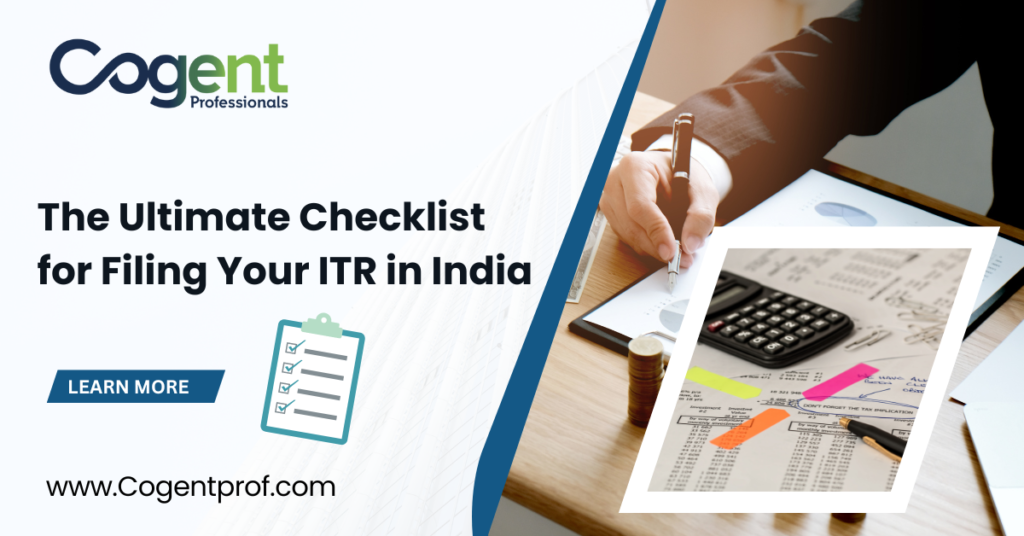
The Ultimate ITR Filing Checklist: Your Comprehensive Guide to a Stress-Free Filing Experience
Filing your Income Tax Return (ITR) in India is a crucial responsibility, but navigating the process can feel overwhelming, especially with deadlines looming. Fear not! This blog post provides your ultimate ITR filing checklist, a comprehensive guide to ensure a smooth and stress-free filing experience.
Whether you’re a seasoned taxpayer or filing for the first time, this checklist will equip you with all the essential steps. We’ll walk you through gathering the necessary documents, understanding your income sources, maximizing deductions, and navigating the e-filing process.
By following this checklist and utilizing the valuable tips along the way, you’ll be filing your ITR with confidence and potentially maximizing your tax refund. So, grab a cup of coffee, ditch the filing anxiety, and let’s dive into the ultimate ITR filing checklist!
Pre-Filing Preparation
Filing your Income Tax Return (ITR) in India can seem like a daunting task, but with proper preparation, it can be a smooth and stress-free process. This section of the checklist will guide you through everything you need to gather and understand before you begin the online filing process.
Essential Documents
- PAN Card: Your Permanent Account Number (PAN) is a crucial identification document for tax purposes. Ensure you have a copy readily available.
- Aadhaar Card: While not mandatory for everyone, having your Aadhaar card handy can simplify the filing process and verification.
- Bank Statements: Bank statements for the relevant financial year will reflect your income from interest earned on savings accounts, fixed deposits, etc.
- Form 16: If you are a salaried individual, your employer will provide you with Form 16, which details your salary income, tax deducted at source (TDS), and other relevant information. You can also access it electronically through the Income Tax e-filing portal or your employer’s online portal.
- Investment Proofs: Keep proof of any investments you made during the year that qualify for tax deductions under various sections. This may include documents related to Equity Linked Savings Schemes (ELSS), Public Provident Fund (PPF), National Pension System (NPS), health insurance premiums, etc.
Understanding Your Income Sources
Before you begin filing, take stock of all your income sources for the financial year. This includes:
- Salary income
- Interest income from various sources
- Income from rental properties
- Capital gains from the sale of assets
- Income from business or profession (if applicable)
A complete picture of your income is essential for accurate tax filing and claiming any applicable deductions.
Tax Deductions and Exemptions
The Indian Income Tax Act offers various deductions and exemptions that can significantly reduce your tax liability. Some common sections include:
- Section 80C: This popular section allows deductions for investments in various schemes like ELSS, PPF, NPS, and others.
- Section 80D: This section provides deductions for medical insurance premiums paid for yourself and your dependents.
- Section 80TTA: This section allows a deduction for interest earned on savings accounts up to a certain limit.
While this is just a brief overview, understanding these deductions can help you minimize your tax burden. It’s important to note that tax laws can be complex. Consider consulting a qualified tax advisor for personalized advice on maximizing your deductions and ensuring accurate tax calculations.
Filing Process Checklist
Now that you’re prepared with all the necessary documents and a clear understanding of your income sources, let’s dive into the actual filing process. This section will guide you step-by-step through the online filing on the Income Tax Department’s e-filing website.
Step-by-Step Guide
- Login: Visit the Income Tax e-filing website and log in using your credentials (PAN number and password).
- Select ITR Form: Choosing the right ITR form is crucial. You can refer to our blog post on “choosing the right ITR form” for detailed guidance on selecting the appropriate form based on your income profile.
- Filling the ITR Form: Once you’ve selected the correct form, the website will guide you through various sections. Here’s a general breakdown of the key sections you’ll encounter:
- Income Details: Carefully enter details of your income from all sources, including salary, interest income, capital gains, rental income, etc., as reflected in the documents you gathered earlier.
- Deductions and Exemptions: This section allows you to claim deductions under various sections like 80C, 80D, etc. Ensure you have the necessary investment proof to support your claims.
- Tax Calculation: Based on your income and claimed deductions, the system will automatically calculate your tax liability.
- Verification and Submission: Once you’ve filled out all sections thoroughly, review your entries for accuracy. After verification, submit the ITR form electronically. The website will provide you with an acknowledgment receipt as confirmation of successful filing.
Post-Filing Tips
Filing your ITR is just one step of the process. Here are some important tips to remember after you’ve submitted your return:
Record Keeping
Maintain a well-organized filing system for all the documents you submit during the ITR filing process. This includes copies of your PAN card, Aadhaar card, bank statements, Form 16, investment proofs, and the ITR acknowledgment receipt.
Having these documents readily available can be helpful in case of any inquiries from the tax department or for future tax filing references.
Tax Payment
Once you’ve submitted your ITR, the system will calculate your tax liability. If you have any tax payable after considering the TDS already deducted, you’ll need to make the payment within the stipulated due date.
The Income Tax e-filing portal offers various online payment options like net banking, debit card, and credit card. You can also make the payment offline through challan at designated banks.
Refund Status
If your ITR filing indicates an excess tax payment or refund due, you can track the status of your refund on the Income Tax e-filing website.
The website allows you to view the processing stage of your ITR and the estimated timeline for receiving any potential refund.
By following these post-filing tips, you can ensure a smooth and hassle-free ITR filing experience.
Wrapping Up
Congratulations! You’ve successfully navigated the process of filing your ITR in India. Remember, this handy checklist can be your go-to guide for a smooth and organized filing experience every year.
Benefits of Using This Checklist
- Reduced Stress: By having a clear plan and understanding of the process, you can avoid last-minute scrambling and filing anxieties.
- Organized Filing: The checklist ensures you gather all the necessary documents beforehand, preventing delays and potential errors.
- Accuracy and Efficiency: Following the step-by-step instructions helps you fill out the ITR form accurately and efficiently.
We encourage you to share this checklist with friends and family who might also benefit from a streamlined ITR filing process. Remember, for complex situations or if you have any doubts, consulting a qualified tax advisor is always recommended.
Don’t fall behind your taxes!
With Cogent Professionals get your taxes done early and enjoy peace of mind.
Visit us at www.cogentprof.com Contact us via email at [email protected] or give us a call at +91 86961 99999



